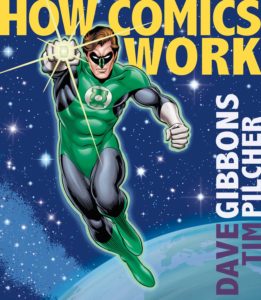 Jump Straight to:
Jump Straight to:
• Books on Writing and Story Structure
• Online Resources
• Books on Drawing (Strip and Illustration)
• Recommended Graphic Novels
Unfortunately, some of these books, (especially the art titles) are out of print and difficult to find. Have a look around used book stores and the local libraries. It’s possible some of your fellow local professionals may have copies you can borrow. Further suggestions always welcome! E-mail me at the address below.
For online resources, visit my Links Page, which includes links to comics artist and writer web sites, publisher contacts and more.
Amazon.co.uk lists over 1300 graphic novel titles in stock
Books on Writing and Story Structure
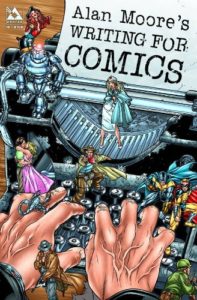 • Alan Moore’s Writing For Comics Volume One
• Alan Moore’s Writing For Comics Volume One
The master of comic book writing shares his thoughts on how to deliver a top-notch script! The main essay was originally written in 1985 and appeared in an obscure British fanzine, right as Moore was reshaping the landscape of modern comics, and has been tragically lost ever since. Now Avatar brings it back in print, collected for the first time as one graphic novel, and heavily illustrated by Jacen Burrows. Moore also provides a brand new essay on how his thoughts on writing have changed in the two decades since he first wrote it.
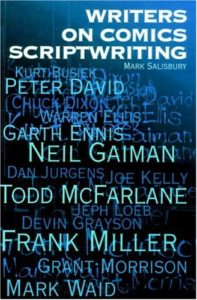 • Writers on Comics Scriptwriting
• Writers on Comics Scriptwriting
by Mark Salisbury. Published by Titan Books. Various essays by comics writers on their work method. Recommended!
The biggest names in comics scriptwriting talk candidly and frankly about their profession, their approach to writing and the comics industry as a whole. Through a series of interviews, these luminaries in the comics field reveal the mechanics of writing for comics and, in the process, a great deal about themselves.
Packed with personal information, contentious views and humorous anecdotes, this is both an exploration of the writer’s craft and a who’s who of the hottest comics’ talent around today, for fans, professionals, would-be writers and for anyone who’s ever wondered exactly how the writer’s mind works.
Gathers together the best writers working in comics today, including Todd McFarlane (Spawn), Garth Ennis (Preacher), Frank Miller (Dark Knight Returns, Sin City), Grant Morrison (Invisibles, JLA) and Neil Gaiman (Sandman), with extracts from the writers’ original scripts.
• Buy Writers on Comics Scriptwriting from amazon.co.uk
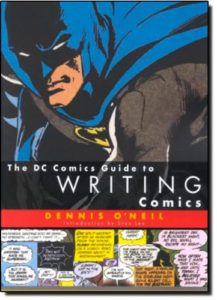 • The DC Guide to Writing Comics
• The DC Guide to Writing Comics
By Dennis O’Neil. US Publication date: May 2001
For any writer who wants to become an expert comic-book storyteller, The DC Comics Guide to Writing Comics is the definitive, one-stop resource!
In this valuable guide, Dennis O’Neil, a living legend in the comics industry, reveals his insider tricks and no-fail techniques for comic storytelling. Readers will discover the various methods of writing scripts (full script vs. plot first), as well as procedures for developing a story structure, building subplots, creating well-rounded characters, and much more. O’Neil also explains the many diverse formats for comic books, including graphic novels, maxi-series, mega-series, and adaptation. Of course, there are also dozens of guidelines for writing proposals to editors that command attention and get results.
• Buy The DC Comics Guide to Writing Comics from amazon.co.uk
• Story: Substance, Structure, Style and the Principles of Screenwriting
by Robert McKee Methuen Publishing Ltd ISBN 0413715604
“Story” deciphers the guiding structural principles that animate every classical and award-winning film, ranging from “Citizen Kane” through to modern acclaimed works like “The English Patient”.
See also on this site McKee’s Ten Commandments of script writing | Cartoon Cliches Exposed
• Writing To Sell
by Scott Meredith. Publisher: Harper & Row
• The Art of Creative Writing
by Lajos Egri. Publisher: Citadel Press
• The Art of Fiction – Notes on Craft For Young Writers
by John Gardner. Publisher: Vintage Books (Random House)
• Teach Yourself Screenwriting
by Raymond G Frensham
Publisher: Hodder & Stoughton
This A to Z of writing for the silver screen comes highly recommended by film writers.
• Movie Making Illustrated
by James Morrow and Murray Sand (1973)
• The Writer’s Little Instruction Book: 385 Secrets for Writing Well and Getting Published
by Paul Raymond Martin
Ideal for anyone with an interest in writing that features practical proven advice, motivation and inspiration.
Online Writing Resources
Alan Moore Interviews
Conducted in two sessions in September and October 2002, and originally serialised in the 2000AD fanzine Zarjaz, Daniel Whiston’s interview with the legendary Alan Moore first appeared on the Engine Comics web site. It’s a fascinating, indepth discussion on the creative process behind his writing, a must read for any fan of literature, archived here on Wayback Machine
Scryptic Studios
A site dedicated to professional and up-and-coming writers – comic writers especially. It was regarded as a must-visit for new comic writers and you can find archives of the no-longer-live site here — everyone is friendly, and are willing to help out. Plus there are scripts, news, writing exercises and advice columns, a many friendly forums.
Interviews with Writers
• SFX: Paul Cornell
Author of Doctor Who TV episodes like “Father’s Day”, the 2007 Christmas’s Telegraph short story “The Hopes and Fears of All the Years”, and Captain Britain and MI-13 for Marvel.
Books on Drawing and Visual Storytelling
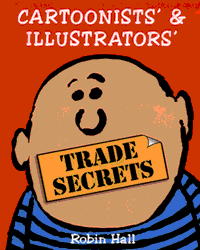 • Cartoonists and Illustrators Trade Secrets
• Cartoonists and Illustrators Trade Secrets
Published by A & C Black, Robin Hall’s Trade Secrets is an excellent book about how to become a successful cartoonist or comics artist, featuring tips from a huge number of professional artists. It also features, with my permission, my online article on Writing for Comics.
• You can buy it from Amazon.co.uk by clicking here
• Artists on Comics Art
by Mark Salisbury. Titan Books. £12.99. Published July 2000
The secrets of graphic storytelling revealed through a series of in-depth interviews with legends such as Brian Bolland, Steve Dillon, Dave Gibbons, Jim Lee, Frank Miller and Alex Ross.
• How Comics Work
Dave Gibbons, Tim Perkins, Wellfleet Press
This brilliant “How It’s Done” book reveals insider hints, tips, and tricks from one of the world’s greatest comic creators in his own words. The artist behind juggernauts like Watchmen and Green Lantern, Dave Gibbons is here to teach you scriptwriting, page layouts, lettering, cover designs, and more, and he’s doing it with scans of original artwork and rarely seen workings to illustrate his personal creative processes. Thoroughly recommended.
• There’s a preview of How Comics Work here on Issuu for those of you who still need to be convinced about buying this book (using this amazon link helps support downthetubes)
• Read my review of How Comics Work here
• The Encyclopedia of Cartooning Techniques
by Steve Whitaker. Paperback – 176 pages (1 July, 1991).
Publisher: Headline. ISBN: 0747277826. No longer in print
This book, written by one of British comics unsung heroes (sadly, no longer with us) provides a comprehensive dictionary of all aspects of the cartoonist’s work, with advice on finding inspiration, drawing techniques, and getting work in print.
Joking aside, if you can find it, this book is worth considering for your shelf.
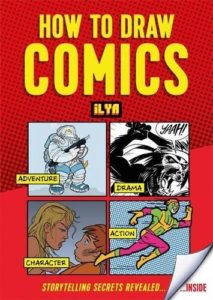 • How to Draw Comics
• How to Draw Comics
by ILYA
Develop your own style as you learn about and practise the principles of drawing comics or graphic novels with this fun and interactive guide.
Written by renowned comics artist Ilya, this is an informal guide to creating comics with captions, speech balloons and sound effects bursting out of every page.
With step-by-step examples, panels for you to complete and space for you to experiment in, this is the perfect way to learn as you find your own style.
Ilya looks at the different styles and genres of comics, focusing on the basics of drawing faces, figures and motion as he progresses to more complex drawings. Learn about using colour, creating mood, the art of the page turn in creating cliffhangers and suspense, and how to make your comic an interactive experience.
Full of useful tips, advice and working examples with space for you to practise and learn, this is the perfect guide for beginners and more experienced comic fans of all ages.
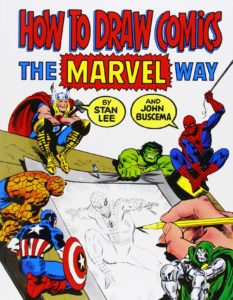 • How to Draw Comics the Marvel Way
• How to Draw Comics the Marvel Way
by Stan Lee and John Buscema. Paperback – 160 pages (October 1986)
Publisher: Titan Books; ISBN: 0907610668The tips and tricks in this book are ones even the hottest artists of the moment still aspire too. It may seem dated but many of the layouts and ideas in this title still hold true today. Worth taking a look and still in print. Highly recommended.
• How to Write and Draw Your Own Comics
by Louie Stowell and various (Usborne)
A fantastic manual on all aspects of comics-making by Louie Stowell and various amazing artists including Jess Bradley, Laura Howell and, um, me again. SORRY. Includes stickers! (I’d be more specific but I haven’t actually seen a copy yet.
But going by this fantastic review from Read It Daddy, it sounds PRETTY GREAT.)
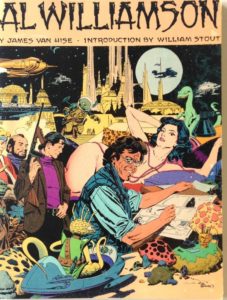 • The Art of Al Williamson
• The Art of Al Williamson
by James Van Hise. Publisher: Blue Dolphin Press
Al Williamson was and is one of the best inkers in the business and this is a wonderful book about his work, including a lot of his newspaper strips featuring Secret Agent Corrigan and Star Wars. It cost me £5.95 a few years ago and it seem to be out of print – but it’s worth trying to find.
One of the things Paul Neary taught me at Marvel was that many of the best artists today are influenced by material drawn many years ago. That isn’t to disparage the talents of new artists, or accusing them of copying (although sadly some do swipe more than they should). But both artists and writers draw on the styles of earlier talents, and the very best learn from this, bringing something new to comics storytelling. No matter the glitz, the basics of comic strip storytelling don’t change from decade to decade. This more than makes Al Williamson’s work worth tracking down, and holds true for the How to Draw Comics the Marvel Way book, too.
• Draw! Alien Fantasies (Learn to Draw: Inspiration & Ideas for Young Artists)
by Damon J. Reinagle Publisher: Peel Productions Inc ISBN 0939217317
Weird alien heroes, helpers, and villains! Space stations, space ships, and astronauts! Step-by-step instructions show you basic techniques, inspirational ideas, plus drawing tips and tricks.
• Draw! Monsters (Learn to Draw: Inspiration & Ideas for Young Artists)
by Damon J Reinagle Publisher: Peel Productions Inc ISBN 0939217341
Damon J. Reinagle turns with obvious relish to a favourite subject of his since childhood. After a Mad Scientist and his assistant and creations (Frankenstein and bride), Dracula and his daughter join the scene…and then a mummy, witch, banshee, and various demons and beasts. Reinagle includes pages on creating creepy letters as well as a diagram of the major bones of the human skeleton. His writing is upbeat and humorous, and the skillful final coloured pencil drawings, despite their subjects, seem to wink at you and say, “see, we’re not really that scary, are we?”
• Draw! Magical Fantasies (Learn to Draw: Inspiration & Ideas for Young Artists)
by Damon J Reinagle Publisher: Peel Productions Inc ISBN 0606092137
Trolls, faeries, elves, and wizards… a world of magical imagination comes to life for budding artists with inspiring step-by-step examples. You’ll find helpful tips and plenty of encouragement. Grab a pencil and let’s get started!
• The Five C’s of Cinematography by Joseph V Mascellie, A.S.C. Paperback – 252 pages (4 August, 1998).
Publisher: Silman James Press; ISBN: 187950541X
With the aid of photographs and diagrams, this text concisely presents concepts and techniques of motion picture camerawork and the allied areas of film-making with which they interact with and impact. Included are discussions on: cinematic time and space; compositional rules; and types of editing.
While it may have been written in a different age of movie-makng, many of the rules and ideas expressed in this book apply today. And my view is, you need to know the rules before you can start breaking them…
• Muscles in Motion: Figure Drawing for the Comic Book Artist
by Glenn Fabry Publishers: Watson-Guptill Publications Inc., U.S. ISBN 0823031454
Comic-book artists are constantly on the lookout for sources for creating those super-human muscles, and now Muscles in Motion is ready to heed their cry for help. While most anatomy and life-drawing books focus on average bodies, Muscles in Motion looks at the musculature of bodybuilders and athletes, and then builds on those physiques to create exaggerated forms that are still strikingly dynamic and realistic. With more than 800 action drawings taken directly from the sketchbooks of legendary artist Glenn Fabry, plus Fabry’s remarkable commentary on those drawings, this is the single best book on action anatomy for comic-book artists, beginning, intermediate, and advanced.
• Pulp Art
by Robert Lessor
This collection is a varied collection of wonderful cover art from the pulp fiction of the early 1920s through the 1940s — Science Fiction, Tarzan, Mysteries, Westerns, Heroic, Romance, and War.
 • Comics and Sequential Art
• Comics and Sequential Art
by Will Eisner
The creator of The Spirit is probably the most universally acknowledged grand master of comic book art (he’s one of my favourite storytellers) and although there’s things in this book I don’t agree with, it makes for a good read and is highly recommended.
Legendary comics creator Will Eisner turns a fine eye toward the principles of graphic storytelling in this extraordinary work based on his popular Sequential Art course at New York’s School of Visual Art. Readers will learn the basic anatomy of sequential art the fundamentals of crafting stones, and how the medium works as a means of expression – a literary form that uses the arrangement of images and words to narrate a story or dramatise an idea.
Eisner’s Graphic Storytelling is another fine read.
 Books by Andrew Loomis
Books by Andrew Loomis
• Successful Drawing
by Andrew Loomis. Publisher: Viking Press
• Creative Illustration
by Andrew Loomis. Publisher: Bonanza Books
• Figures in Action
by Andrew Loomis. Paperback – 32 pages (December 1995).
Publisher: Apple Press; ISBN: 1560100095
There are more books by Loomis here on amazon.co.uk
• Bridgman’s Complete Guide to Drawing from Life
by George Bridgman. Hardcover – 360 pages (May 1992).
Publisher: Wings Books; ISBN: 0517255464
• How To Use Creative Perspective
by Ernest W Watson
In this thought-provoking practical guide, a noted artist and educator demonstrates that learning to violate the rules of perspective (profitably) is as important for the practicing artist as learning the principles of perspective themselves. Only in this way can students free themselves from the constraints of tradition and find their own imaginative paths. However, it is vital that students first have a solid grasp of classical perspective before they can think about adapting it creatively.
In presenting the principles of perspective drawing, Watson devotes a chapter each to step-by-step discussions of such topics as the picture plane, foreshortening and convergence, the circle, the cone, three-point perspective, universal perspective, figures in perspective, and much more. To illustrate his points he offers expert analysis of the works of such leading illustrators as John Atherton, V. Bobri, R. M. Chapin, Jr., Albert Dorne, Robert Fawcett, Constantin Guys, W. N. Hudson, Carl Roberts, Ben Stahl, and Aldren A. Watson, as well as drawings by Pieter de Hooch and Paul Cézanne. The result is a ground-breaking study that artists, illustrators, and draftsmen will find invaluable in learning to create works with convincing perspective.
Ernest W. Watson taught at Pratt Institute for over 20 years, co-founded and served as editor-in-chief of the magazine American Artist, and co-founded the prestigious art publishing house of Watson-Guptill.
• The New Drawing on the Right Side of the Brain
by Betty Edwards
Hardcover – 306 pages [New Ed.] edition. Souvenir Press Ltd
By applying discoveries in brain research to the teaching of drawing, this book is designed to help anyone improve their drawing.
Sections on drawing in colour, new information on using lights and shadows to create 3-D effects, improving handwriting and exercises are also included. This basically says if you can write, you can draw and the valedictions on Amazon.co.uk’s page for this title suggest the author is on to something…
Selling Your Comics
• How to Draw & Sell Comics Strips
Alan McKenzie, Titan Books
Aspiring comics writers and artists get enough discouragement on the rocky and rejection-filled road to success. That’s why they’ll be relieved to know they can seek advice from former 2000AD editor Alan McKenzie, who has written How to Draw & Sell Comics Strips. This edition from Titan Books, first published by them back in 1998, covers everything from the three-panel funnies to fully-fledged graphic novels and beyond.
McKenzie offers a plethora of examples from the history of the comic book medium to illuminate the entire process, beginning with a history of the medium and continuing through the many stages of writing, pencilling, inking, and computer colouring to arrive at the finished product. As well as providing authoritative and practical advice on the creation of comics, the book offers guidance on getting published for the first time, and how to generate ideas when the freelance work finally arrives.
This is a completely new edition of this book, fully revised, rewritten and updated with a host of new content and all-new examples, as well as a fully-current appendix of contact details for all the leading US and UK publishers and syndicates.
It’s also a great complementary title to Titan’s other comics reference titles that include How to Draw Comics The Marvel Way, which has sold over 75,000 copies in the UK since it was first published way back in 1984, and the popular Comics Creators series.
Alan McKenzie is an industry professional with over 20 years experience in creating comic strips. He started his comics career at Top Sellers, and then moved to Marvel Comics UK, where he edited the SF magazines Starburst and Doctor Who. He then became a contributing editor at 2000AD, also writing the Judge Dredd strip in the Daily Star.
• Click here to buy How To Draw & Sell Comic Strips from Amazon.co.uk
Recommended Graphic Novels
Available by mail order and from all good bookshops and Amazon.co.uk
If you are a librarian seeking information on possible graphic novels for purchase, you might like to buy Son Of Invisible Art: Graphic Novels For Libraries compiled by Joss O’Kelly. It was published in 2001 by the Library and Information Service for Schools and is available from amazon.co.uk and Buckinghamshire County Library, Walton Street, Aylesbury, Bucks HP20 1UU, price £5. ISBN: 0 86059 605 2. The book is also sold by Strangehaven publisher/creator Gary Spencer Millidge on his stalls at comic fairs.
The book was never intended to be a definitive listing, but an annotated guide for librarians buying stock, and of course it’s now a few years out of date — although most of the books are still available.
• The Batman Adventures
Kelley Puckett, Martin Pasko, Ty Templeton, Brad Rader, Rick Burchett
Paperback – 143 pages (30 October, 1998)
Publisher: Titan. ISBN:1563890984
Based on the stunning cartoon series this comic strip continues to maze with its sleek simplIcity of line and fast-paced yet elegant storytelling. A must for any graphic novel bookshelf.
• Batman Beyond
Hilary J. Bader, Rick Burchett, Joe Staton
Paperback – 152 pages (28 April, 2000)
Titan Books; ISBN: 1840231629
This collection of the first Batman Beyond comics truly reflects the energetic, enthusiastically-written Batman dropped kicking and screaming into the 21st Century!
• Batman: Year One
David Mazzucchelli (Illustrator), Frank Miller, Richard Bruning (Editor)
Paperback – 98 pages (October 1997)
DC Comics; ISBN: 0930289331
This re-telling of the Batman origin — the sort of ‘wasteland years’ between the death of Bruce Wayne’s parents at the hands of a gunman and Batman’s first missions — is loving told and superbly rendered. Frank Miller effectively kicked new life into Batman, reinvigorating the character for a more cynical age by recognising the strengths of the original character created way back when. What he did with Marvel’s Daredevil he does here with Batman and it works, aided tremendously by partner in crime, David Mazzucchelli.
• Batman: the Dark Knight Returns
Frank Miller, Klaus Janson (Illustrator), Lynn Varley (Illustrator), Alan Moore (Introduction)
Paperback – 200 pages (15 September, 1994)
Publisher: Titan Books; ISBN: 1852867981
Before Year One, there was Dark Knight Returns — one of those few graphic novels to break out of the comics ‘ghetto’ and earn the attention of the mainstream media. Even now, many years on, there’s talk of turning this epic into a movie with Joel Schumacher nowhere in sight.
Whatever its future, Dark Knight was a fine story when it first appeared as a comic and an even greater git as a graphic novel. If you have limited space on your shelves for such items, this should be one of your Desert Island Disc-style choice.
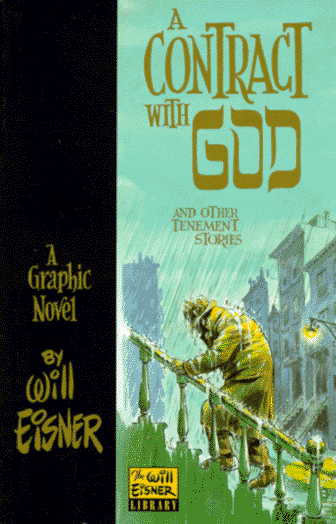 • A Contract With God
• A Contract With God
by Will Eisner
Paperback (September 1985)
Kitchen Sink Pr (Nrt); ISBN: 0878160183
This was the first graphic novel I ever bought. I’m very glad I did because it was also my first introduction to the stunning work of the late Will Eisner, creator of The Spirit. Strangely, for all its ground-breaking kudos I’ve never really enjoyed The Spirit but Eisner’s city stories have always proven a draw (no pun intended). Well worth a try, in my humble opinion.
• Hellboy Book 1: Seed of Destruction
Mike Mignola, John Byrne, Mik Mignola
Paperback – 128 pages (June 1997)
Dark Horse Comics; ISBN: 1569713162
Never mind the book, where’s that movie? Well, it’s out there somewhere. In the meantime, check at least some of the source material in this excellent work from another artist favourite of mine, Mike Mignola. Myth, magic and mayhem as a demon beats up other demons in one neat package.
• Kingdom Come
Mark Waid, Alex Ross (Illustrator)
Paperback – 228 pages (August 1997)
Titan Books; ISBN: 1852868163
A vision of the superhero universe, Elseworlds. It’s judgement day, and war is about to be waged between superheroes old and new, one that will determine the fate of the entire planet.
If you’ve stuck with me this far down the page you’ll notice a running theme to this feature — nothing but the best, and this is one of the best. Not only is it a terrific tale of an alternate DC Universe; it’s also packed with hundreds of visual references to past DC characters and more. Waid is one of THE best writers out there at present and the combination of his words and Ross’ stunning visuals more than make this an essential buy. (So buy it!)
• Maus : A Survivor’s Tale Volume 1
Art Spiegelman
Paperback – 159 pages (September 1986)
Pantheon Books; ISBN: 0394747232
You could be forgiven for thinking the holocaust isn’t an expected subject matter for a comic strip but you’d be wrong; in fact, if nothing else Maus shows everyone how versatile the comics form can be in terms of storytelling. This dark tale of one of the worst events in human history should never be forgotten and work like this should ensure it won’t be.
• Sin City: To Hell and Back
by Frank Miller
Paperback – 320 pages (June 2005)
Titan Books; ISBN: 1845760514
Sin City is a dark and seedy world full of lowlife and scum, a place where people die easy and love dies hard. Violent Marv is a criminal who is tougher than leather, harder than nails, and spurred on by love. Winner in the Best Comic Book category in the 1992 National Cartoonists Society awards.
This updated version of Miller’s first Sin City opus is a stunning piece of work.I’d also recommend reading any of his Daredevil work for Marvel: or titles such as Ronin.
• The Sandman: Dream Country
Neil Gaiman, Kelley Jones (Illustrator), Charles Vess (Illustrator), Colleen Doran (Illustrator), Steve Erickson (Introduction)
Paperback – 160 pages (July 1992)
Titan Books; ISBN: 1852864419
This collection of stories in comic strip form includes an interpretation of Shakespeare’s “A Midsummer Night’s Dream”, alongside “Calliope”, “A Dream of a Thousand Cats” and “Facade”. Also included is the annotated script for “Calliope”, showing the process behind creating a comic-book.
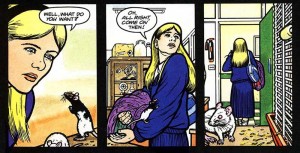 • The Tale of One Bad Rat
• The Tale of One Bad Rat
by Bryan Talbot
Paperback – 132 pages (November 1995)
Titan Books; ISBN: 1852866896
Running away from the nightmare of sexual abuse, Helen Potter finds herself treading in the footsteps of the children’s storyteller, Beatrix Potter. Across the decades, two lives touch, and Helen discovers that the strength of two is far greater than that of one.
This is a powerful tale, movingly told and rendered by Preston-based comics artist Bryan Talbot, also known for his The Adventures of Luther Arkwright. The subject matter never verges to the voyeur and all in all this is an impressive tale. And you’ll even learn some surprising things about rats, too!
• Watchmen
Paperback – 416 pages (November 1995)
Titan Books; ISBN: 1852860243
Imagine a future where Nixon is still President, America won the Vietnam War, and the nuclear clock stands at five minutes to midnight.
“A comic book for adults who don’t read comics,” says one of Amazon’s reviews for this title and that about sums it up. Moore and Gibbons superhero mystery/tragedy/adventure is a classic tale and another book that put graphic novels on the map with the mainstream media — no easy task in the UK where for some reason comics always seem to be equated with The Beano.
• That Yellow Bastard
By Frank Miller
Titan Books; ISBN: 1845760484
Meet Lieutenant John Hartigan, one hour left on the force and one case left to close. There are no mysteries left now, just “Junior”, a sick brat with a powerful senator for a father, a kidnapped 11-year-old girl, and a taste for rape and murder.
This “Sin City Saga” nook is as gripping as the rest of the series: Miller remains one of my favourite comics creators, always challenging, always pushing the envelope of comics story telling. A must!
